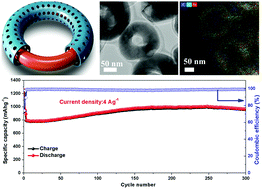Yolk–shell structured metal oxide@carbon nanoring anode boosting performance of lithium-ion batteries†
Abstract
Nanostructured transition metal oxide anodes have attracted considerable attention for high-performance lithium-ion batteries (LIBs). However, their low rate capability and rapid capacity decline resulting from their low electronic conductivities and inevitable substantial volumetric changes prevent them from being commercialized as anodes for LIBs. Herein, we design a high-performance anode for LIBs consisting of a yolk–shell structured Fe2O3@C nanoring (NR) composite that comprises a NR-like Fe2O3 core entirely protected by a fine porous carbon (C) shell to overcome such obstacles. This advantageous yolk–shell structural design can buffer the significant volume variations of Fe2O3 cores without damaging the microstructure of the electrode. Thanks to the unique structural features, the as-built electrode shows a remarkable electrochemical performance, namely, a large specific capacity of 846 mA h g−1 after 100 cycles at 0.2 A g−1, a superior rate performance of 688 mA h g−1 at 4 A g−1, and a remarkable cycling life (300 cycles, 945 mA h g−1 at 4.0 A g−1). Hence, this electrode is much better than a pure Fe2O3 NR electrode.



 Please wait while we load your content...
Please wait while we load your content...